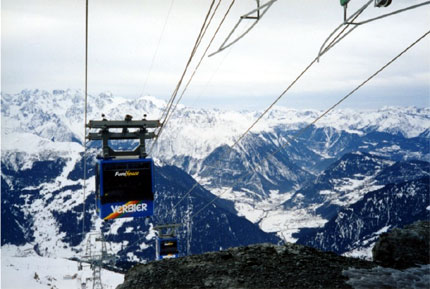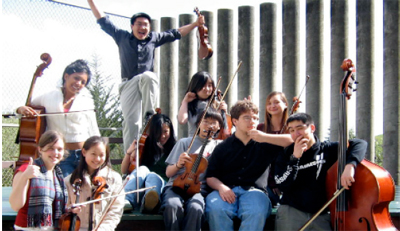Two of S21’s favorite people are getting married…to each other. One of them is Brian Sacawa. The other member of the wedding is playing it coy but feel free to guess. Unless, of course, you know for sure, in which case hold it down until the intended makes the news public. Steve Smith gets credit for making the shidekh.
With at least 135 recordings (by my quick count) now in circulation, one would think there wasn’t much Philip Glass music that hasn’t already been submitted for the judgment of history. One would be wrong.
Orange Mountain Music has just released the second of a planned series of 10 CDs winnowed from the vast archives that Glass has assembled over the past 40 years. The recordings—most of them captured during live performances–span the entire range of Glass’ work and include music for film, theater, dance, and concert hall in a wide variety of scores including chamber music, solo instruments and orchestral works.
 The first CD in the series, From the Philip Glass Archive –Theater Music Vol. 1, was released a few months back and contains two atypical Glass pieces in that there are few repeating arpeggios, not much of a driving pulse, and a lot of intimate touches. The first is a suite from Glass’ 2003 opera, The Sound of a Voice, the setting of two stories of Japan from a libretto by David Henry Hwang. Scored for violin, cello, flute, and pipa, the suite combines Eastern and Western in a light, engaging manner despite a few nasty coughs from sickly audience members. (Stay home, people!)
The first CD in the series, From the Philip Glass Archive –Theater Music Vol. 1, was released a few months back and contains two atypical Glass pieces in that there are few repeating arpeggios, not much of a driving pulse, and a lot of intimate touches. The first is a suite from Glass’ 2003 opera, The Sound of a Voice, the setting of two stories of Japan from a libretto by David Henry Hwang. Scored for violin, cello, flute, and pipa, the suite combines Eastern and Western in a light, engaging manner despite a few nasty coughs from sickly audience members. (Stay home, people!)
The second suite is drawn from music created for Jane Bowles’ 1953 play, In the Summer House, which was directed by Glass’ first wife Joanne Akalaitis. Scored for violin and cello, the piece is divided into 18 short movements, each more ravishing than the one before it. There is something to be said for being young and in love.
 From the Philip Glass Archive – Vol. 2: Orchestral Music dips into Glass’ “world music” bag for Days and Nights in Rocinha, a 23-minute musical tribute to the Brazilian neighborhood that is home to the world-famous “samba school” and a place that Glass’ frequented often in the 1980’s and 1990’s. The piece was premiered in 1998 as a Dance for Dennis Russell Davies and Orchestra by the Vienna Radio Symphony Orchestra. It’s an engaging piece that demonstrates once again that Glass coasting is better than most composers trying their damnedest.
From the Philip Glass Archive – Vol. 2: Orchestral Music dips into Glass’ “world music” bag for Days and Nights in Rocinha, a 23-minute musical tribute to the Brazilian neighborhood that is home to the world-famous “samba school” and a place that Glass’ frequented often in the 1980’s and 1990’s. The piece was premiered in 1998 as a Dance for Dennis Russell Davies and Orchestra by the Vienna Radio Symphony Orchestra. It’s an engaging piece that demonstrates once again that Glass coasting is better than most composers trying their damnedest.
The second work on the disc is titled Persephone and is a challenging 5-movement, 27 minute tour-de-force for orchestra and voices, created for a Robert Wilson theatrical installation from 1994. Astute listeners will note that the dramatic high point of the piece—the fourth movement “Cocktail Party”–is borrowed from Glass’ Piano Etude No. 6 but, hey, if you can’t steal from yourself… The piece is performed admirably by The Relache Ensemble.
So today’s musical question is this: What is the best strategy for managing your compositional “brand?” Put it all out there and let history sort it out (like Glass, Martinu and many others) or publish and record only those things you think future generations will hear favorably (like, say, Varese).
Conlon Nancarrow died 10 years ago today in Mexico City. Pliable has a nice writeup, and quotes György Ligeti praising Nancarrow as the most important composer of the second half of the twentieth century. I like Nancarrow but that strikes me as generous and raises the question–important to whom? To other composers? Maybe. To the small percentage of human beings who like contemporary classical music? No way.
UPDATE: Here’s the Kyle Gann link I was looking for.
“I had always heard by reputation of the high regard accorded the folk-ballad singer/songwriter Bob Dylan. But I was so engaged in developing my orchestral technique during the years when Dylan was heard by the rest of the world that I had never heard his songs. So I bought a collection of his texts.” John Corigliano, in program notes for his Mr. Tambourine Man: Seven Poems of Bob Dylan
On the other hand, Dylan probably didn’t catch The Ghosts of Versailles either.
FOR IMMEDIATE RELEASE
Fallto: New Release from Drifting In Silence
Chicago,IL – August 7, 2007 – Labile Records announces its latest release from recording artist Drifting In Silence.
The latest release, Fallto, is a continuation and further development of themes introduced in Truth, and Ladderdown, from 2005 and 2006, respectively, completing the cycle of this trilogy work.
Fallto has been described as shoegaze meets dancing shoes. Listeners familiar with previous work from Drifting In Silence will recognize the trademark prismatic tonalities and looping rhythms suspended in an ambient mix. Fallto brings these previous threads together, and makes its own statement with edgy timbres and hard driving beats that punch through their atmospheric setting in unexpected ways. If Truth and Ladderdown were explorations in clouds and shadows, Fallto is clouds and shadows moving at the speed of an express train.
Fallto further explores the use of voices and lyrics, rendered faithful to the mix by judicious but delightfully risky application of filters and vocoders. True to the established Drifting In Silence aesthetic, the voices in Fallto are part of the instrumentation. Standout tracks include “Texture” and “Unknowndivide,” which features Jess Hewitt of Drev. Also two separate remixes from Drev and 3l3tronic of the vocal-laced “Chameleon,” injecting industrial-quality breaks and a sick vocal filter, to make for a dance floor smash.
Debuting at #5 on the CMJ RPM most added report for issue 1019. Fallto is available now on
and wherever fine alternative music can be found.
 I don’t ski. Asthma. And fear. Mostly fear.
I don’t ski. Asthma. And fear. Mostly fear.
I used to party a bit though and because many of my companions were ski buffs, I have socialized, but not skied, at some of the best places in the world. I have not skied Kitsbuehl and Chamonix and Lillehammer, for example. I have not skied Aspen and Telluride and Jackson Hole. Especially, I have not skied Verbier, the favorite hangout of some rowdy Norwegians of my acquaintance. We have been thrown out of the Feed Club, Verbier’s most lively nightspot, not once, but twice over the years, not a record I’m sure but respectable for middle-aged businessmen.
Alas, I have never attended the Verbier Festival, which has become one of the best music festivals in Europe in recent years. Fortuntately for all of us, they have a terrific web site when you can view all of the performances, including the August 1 premiere of our familiar Avner Dorman’s Spices, Perfumes and Toxins, under the direction of Zubin Mehta. For more Dorman, check out the Metropolis Ensemble’s performance last May of his Mandolin Concerto.
And, welcome back to the S21 blogging fold Judith Lang Zaimont.
Some interesting fodder for conversation in this month’s Gramophone. Item #1, there are more than 4,000 one-handed piano pieces for the left hand but no more than 75 for the right. Jeremy Nichols reckons that it’s because when great pianists are injured it is invaribly their right arm. His evidence is purely anecdotal, but convincing.
Item #2 is related to this week’s big Focus on Death meme. We all know that cigarette smoking killed Webern but did you know that Enrique Granados died after the ship he was on was torpedoed by a U-boat and he jumped out of a lifeboat to try and save his wife who was in the water? Gramophone’s list is pretty well-known. How about some contemporary updates?
Anybody do Tanglewood? Give us a report.
Check out Frank J. Oteri’s great interview with Indie rockers Matthew and Eleanor Friedberger, aka The Fiery Furnaces, over at New Music Box. Thanks for the shout-out, dude.
Michelangelo Antonioni, 94, on Monday, same as Bergman.
Bergman and Antonioni. Contrast and compare.

Seems like only yesterday we reported that Matthew Cmiel, one of our favorite boy wonders, had put together a new band called Formerly Known as Classical. (Actually, it March 15, 2006, but let’s not quibble.) Looks like the group has done okay since last we checked in; on Sunday, August 5, they’re appearing in a concert at the Cabrillo Music Festival with Marin Alsop, the conductor and music director of the Baltimore Symphony and recent MacArthur Prize winner.
Matthew–now a sobering 18-years-old–will conduct the group in Osvaldo Golijov’s Last Round, an exciting piece of music which gets its title from a story about boxing by Julio Cortazar and is an homage to Astor Piazzolla the late master of neuvo tango.
Then, recent Juilliard graduate, cellist Drew Ford and San Francisco Symphony Youth Orchestra pianist Preben Antonsen will play Matthew’s piece Macho, Cool and Dangerous, which was inspired by the music of Golijov and Piazzolla.
The concert is Sunday, August 5 at 8:00 PM in the Sant Cruz Civic Auditorium, 307 Church Street, Santa Cruz. If you’re in the neighborhood, write us a review.
Hey, the Steve Layton Songbook is coming along nicely. Check out Prufrock (T.S. Eliot) 2007.